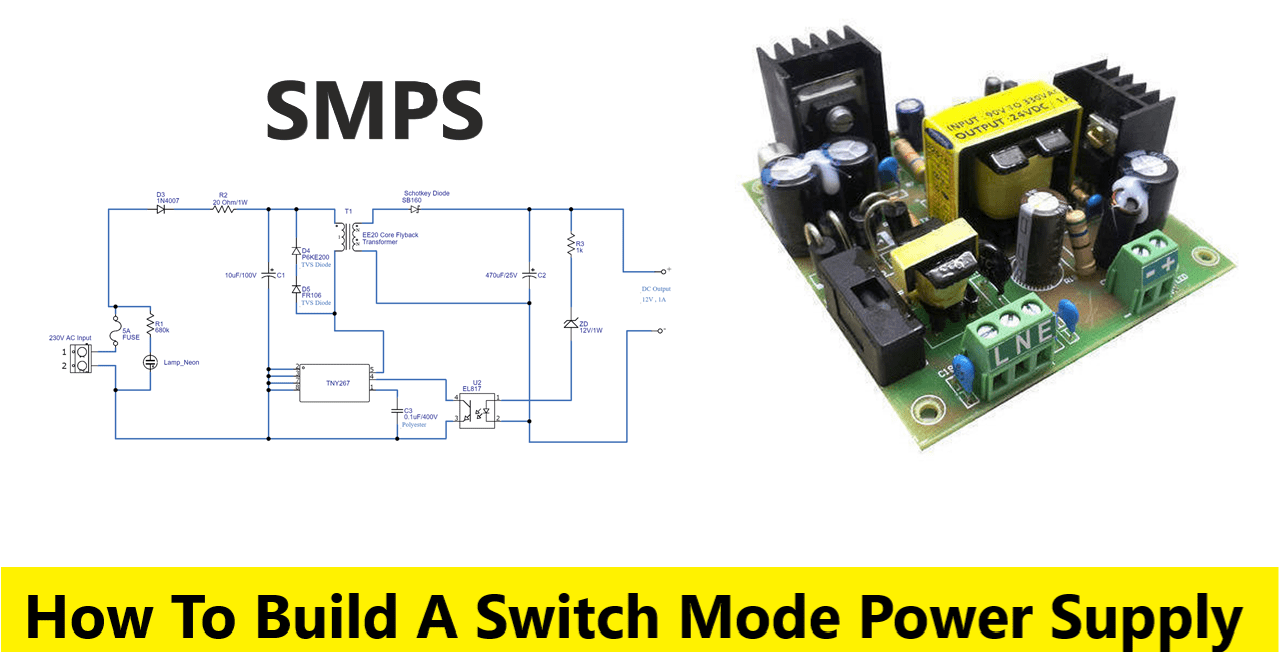
In the ever-evolving landscape of electronics, the demand for efficient and compact power supplies has led to the widespread use of Switch Mode Power Supplies (SMPS). SMPS offers higher energy efficiency and smaller form factors compared to traditional linear power supplies. In the following article, we will see how to build a switch mode power supply for practical use for various applications.
Before moving to the building of SMPS, let us understand what is an SMPS?
What is SMPS?
SMPS, which is called Switch Mode Power Supply is an electronic circuit that converts Electrical power from one voltage to another. SMPSs are also known as switching power supplies or switchers.
Operating Principle of Switch Mode Power Supplies
SMPS utilizes sophisticated switching devices like MOSFETs, which continually switch on and off at high frequencies.
Energy storage components such as capacitors and inductors play a crucial role in supplying power during the non-conduction state of the switching device.
The operational principle of Switch Mode Power Supplies involves the rapid switching of a power semiconductor device on and off.
This distinctive approach to energy flow control results in a more efficient conversion of electrical energy, marking a departure from the continuous operation seen in linear power supplies.
Efficiency and Size
SMPS boasts higher efficiencies, reaching up to 90%, making them a preferred choice for various applications.
Their compact size is a notable characteristic, contributing to their widespread use in computers and other sensitive electronic equipment.
How to Build a Switch Mode Power Supply and its Working
Let us now understand the building of Switch mode Power Supply
The design and working of SMPS is divided into various sections and stages:
Input Stage (Stage 1)
The AC input supply with a frequency of (50-60) Hz is directed to the rectifier and filter circuit.
The output, characterized by various fluctuations, requires a capacitor with sufficient capacitance to handle input variations.
The unregulated DC output is then fed into the central switching section of the SMPS for regulation; this section operates without a transformer for the step-down in input voltage supply.
Switching Section (Stage 2)
Comprising fast-switching devices such as a Power transistor or a MOSFET, this section toggles ON and OFF in response to voltage variations.
The resulting output is directed to the primary of a smaller, lighter, and highly effective transformer, facilitating voltage step-down.
The efficiency of this transformer surpasses alternative step-down methods, contributing to a higher power conversion ratio.
Output Stage (Stage 3)
The output from the switching section undergoes rectification and filtering to achieve the desired DC voltage.
The regulated output voltage is then supplied to the control circuit.
Control Unit (Stage 4)
The control unit is primarily focused on feedback and encompasses various sections.
The internal control unit includes an oscillator, amplifier, sensor, etc.
The sensor detects the output signal and provides feedback to the control unit, ensuring isolation of signals to prevent sudden spikes from affecting the circuitry.
A reference voltage and the signal are input into the error amplifier, which functions as a comparator, comparing the signal with the required signal level.
The subsequent stage involves controlling the chopping frequency, with the final voltage level adjusted based on the inputs to the error amplifier.
The oscillator generates a standard PWM wave with a fixed frequency.
Applications of Switched Mode Power Supply (SMPS)
Deployment in servers, power stations, and personal computers for diverse electronic applications.
Integration into vehicles for battery charging purposes.
Application in factories and industries to meet power requirements.
Implementation within the railway system and security systems for efficient power management.
Advantages of Switched Mode Power Supply
Smaller physical footprint and reduced weight compared to alternative power supply options.
Demonstrates superior power efficiency, typically ranging from 60 to 70 percent.
Possesses strong resistance against external interference, ensuring stable performance.
Offers a wide range of output options, catering to diverse voltage requirements.
Generates minimal heat during operation, contributing to improved energy efficiency.
Disadvantages of Switched Mode Power Supply
The design and operation of SMPS are more intricate and may require specialized knowledge.
Tends to exhibit higher output ripple, and regulation may fall short of expectations.
Primarily limited to applications requiring step-down regulation.
May introduce high-frequency electrical noise into the system, potentially impacting other components.
Leads to harmonic distortion, which can be a concern in certain applications.
Conclusion:
By following the above guidelines you will be able to make your own Switch Mode Power Supply. If you are looking for SMPS from brands such as Mornsun reach out to Electronic component supplier - Campus Component today!. We have an exciting range of SMPS as per your application needs such as Mornsun LM50 SMPS, Mornsun LM150 SMPS, Mornsun LI120 SMPS and much more.

